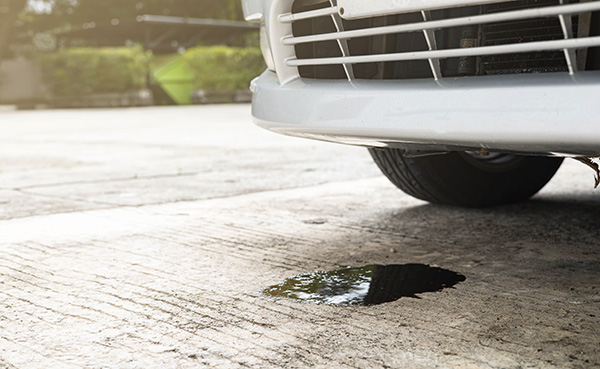
A few drops of oil on the driveway might not look like a big deal. Many drivers top off the level and keep going. The truth is that small oil leaks often turn into expensive problems, and the damage can happen quietly long before a warning light appears.
If you have noticed spots under your car or a burning oil smell after parking, now is the time to understand what is leaking and why it matters.
Why Engines Leak Oil in the First Place
Engines rely on seals and gaskets to keep oil where it belongs. Heat cycles, age, and vibration slowly harden rubber and flatten gasket material. Common leak points include valve cover gaskets, oil filter housings, oil pan gaskets, cam and crank seals, and the oil pressure sender. Turbocharged engines add more heat, which accelerates wear on nearby seals. Even a loose or incorrectly installed oil filter can seep.
Small Leak, Big Risk to Oil Pressure
Oil is not just a lubricant. It also creates pressure that feeds critical parts such as camshafts, lifters, and the turbo bearing, if equipped. A slow leak lowers the oil level, which makes the pump work harder and can expose the pickup during hard stops or tight turns. Brief drops in pressure may not trigger a light, yet metal parts still run with less protection. Over time, that means extra wear, noisy lifters, and timing components that do not last as long as they should.
Hidden Effects You Can Smell or See
You may not see an obvious drip, but the car can still be losing oil. A few clues to watch for:
- A hot, sharp odor after parking that hints at oil hitting the exhaust
- Damp or shiny edges along the valve cover or oil pan
- Smoked residue near the catalytic converter or by the radiator fan
- Oil mist on the underside of the vehicle or on the splash shield
These signs point to a leak that is landing on hot parts. Besides the smell, this creates smoke and increases the risk of heat damage to wiring, oxygen sensors, and rubber hoses.
How Leaks Create Sludge and Cooling Problems
Oil that seeps around a gasket attracts dirt. That grime forms a sticky layer that traps heat. Heat is the enemy of gaskets and plastic parts, so the leak slowly grows. Inside the engine, low oil levels allow varnish and sludge to form, especially if oil changes are overdue. Sludge restricts tiny oil passages and can starve variable valve timing components. In severe cases, sludge blocks the return paths in the cylinder head, which keeps hot oil from draining back to the pan and pushes temperatures even higher.
When a Slow Leak Turns into a Rapid One
Some leaks stay small for months, but others accelerate without warning. A worn seal can split. An old oil cooler line can rupture. A loose filter can back off with vibration. If the red oil pressure light appears, shut the engine off immediately and arrange a tow. Driving with that light on, even for a minute, can damage bearings and score the crankshaft. That is the difference between a straightforward gasket job and a full engine rebuild.
Top Off or Fix It Right Away
Topping off keeps the dipstick in the safe zone, but it does not address the problem of seals wearing out and attracting dirt. Fresh oil may also mask how much is leaking because it burns off cleanly. A proper repair starts with pinpointing the source, not guessing. Shops use UV dye and a detailed cleaning of the area, then recheck after a short drive to confirm the exact gasket or seal. This avoids replacing the wrong parts and helps you spend money where it actually solves the leak.
Prevention Comes Down to Maintenance Habits
Clean, correct-spec oil protects seals and keeps varnish from forming. Follow the time interval, not just the miles, if the vehicle makes short trips. Replace a crushed drain plug washer at every oil change. Inspect the PCV system on schedule, since excessive crankcase pressure will force oil past otherwise healthy seals. If your engine uses timing components that sit behind a front cover, consider replacing front seals when those parts are serviced to avoid duplicate labor later.
What a Professional Inspection Includes
A thorough leak check is more than a quick look from above. A good inspection raises the car, removes the splash shield, and checks the oil filter housing, cooler lines, pan gasket, and rear main area. Valve cover edges are examined with a mirror and light. If the leak seems high on the engine, the technician may clean and run the car briefly, then look for fresh wetness. If a burning smell is present, the exhaust manifolds and catalytic converter shields are inspected for oil residue that could create smoke.
Engine Oil Leak Repair in Hanover Park That Protects the Whole Vehicle
Ignoring that small spot on the driveway can shorten engine life, damage sensors, and create a fire risk if oil reaches hot exhaust parts. Finding the exact source and fixing it early is the best way to protect your engine and avoid bigger repairs later. If the dipstick keeps dropping between changes, or you smell hot oil after parking, it is time for a focused inspection.
Stop Oil Leaks with Kamphaus Auto Care in Hanover Park, IL
Kamphaus Auto Care tracks down the source of oil leaks with dye, pressure checks, and a clean-to-confirm process, then repairs the exact gasket, seal, or line that failed. We use the correct sealants and torque specs so the repair lasts, and we clean any residue that could create odors or smoke.
Schedule a visit today to protect your engine, your driveway, and your peace of mind.